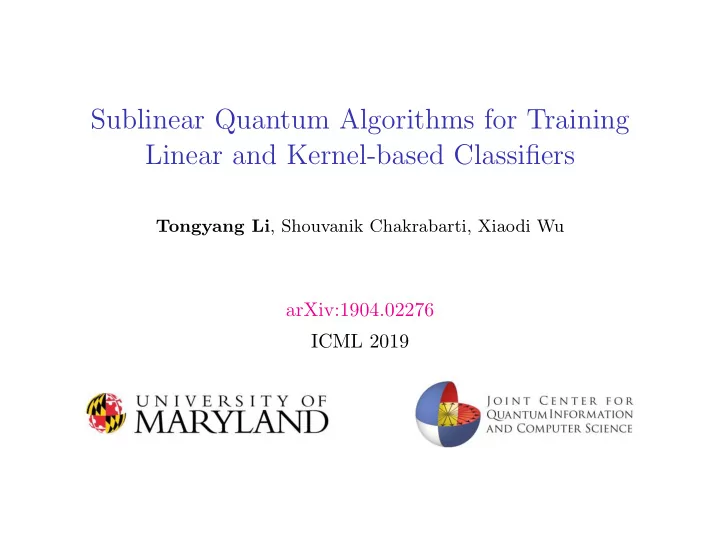

Sublinear Quantum Algorithms for Training Linear and Kernel-based Classifiers Tongyang Li , Shouvanik Chakrabarti, Xiaodi Wu arXiv:1904.02276 ICML 2019
Why Quantum Machine Learning? ◮ Quantum machine learning is becoming more and more relevant: - Theoretical physics has motivated many ML models (Ex. Boltzmann machine, Ising model, Langevin dynamics, etc.) - Classical ML techniques can be applied to quantum problems. - Quantum computers give speedup for training models. - · · · · · ·
Why Quantum Machine Learning? ◮ Quantum machine learning is becoming more and more relevant: - Theoretical physics has motivated many ML models (Ex. Boltzmann machine, Ising model, Langevin dynamics, etc.) - Classical ML techniques can be applied to quantum problems. - Quantum computers give speedup for training models. - · · · · · · ◮ Quantum computers are developing fast, having 50-100 qubits now: Maryland & IonQ IBM Google Noisy, intermediate-scale quantum computers (NISQ); practical quantum computers to come in 5-10 years
Our Contribution A promising quantum ML application: classification X T w ≥ σ X T w = 0 X T w ≤ − σ M a r g i n = σ
Merits of our quantum classifier
Merits of our quantum classifier ⊲ Near-term implementation: Highly classical-quantum hybrid with the minimal quantum part; suitable for NISQ computers.
Merits of our quantum classifier ⊲ Near-term implementation: Highly classical-quantum hybrid with the minimal quantum part; suitable for NISQ computers. ⊲ Composability: Purely classical output, suitable for end-to-end machine learning applications.
Merits of our quantum classifier ⊲ Near-term implementation: Highly classical-quantum hybrid with the minimal quantum part; suitable for NISQ computers. ⊲ Composability: Purely classical output, suitable for end-to-end machine learning applications. ⊲ Generality: The classifier can be kernelized.
Main Results Given n data points with dimension d , our quantum algorithms train √ O ( √ n + classifiers for the following problems with complexity ˜ d ): ⊲ Linear classification: X ⊤ w ⊲ Minimum enclosing ball: � w − X � 2 ⊲ ℓ 2 -margin SVM: ( X ⊤ w ) 2 ⊲ Kernel-based classification: � Ψ( X ) , w � , where Ψ = polynomial kernel or Gaussian kernel. The optimal classical algorithm runs in ˜ Θ( n + d ) (Clarkson et al. ’12).
Highlights of Our Quantum Algorithm
Highlights of Our Quantum Algorithm ◮ Standard quantum input: coherently access the coordinates of data, like a Schr¨ odinger’s cat:
Highlights of Our Quantum Algorithm ◮ Standard quantum input: coherently access the coordinates of data, like a Schr¨ odinger’s cat: ◮ Speed-up: The classical ˜ Θ( n + d ) optimal algorithm by Clarkson et al. uses a primal-dual approach: ⊲ Primal: O ( n ) by multiplicative weight updates. ⊲ Dual: O ( d ) by online gradient descent. Quantum: quadratic speed-ups for both the primal and dual.
Highlights of Our Quantum Algorithm ◮ Standard quantum input: coherently access the coordinates of data, like a Schr¨ odinger’s cat: ◮ Speed-up: The classical ˜ Θ( n + d ) optimal algorithm by Clarkson et al. uses a primal-dual approach: ⊲ Primal: O ( n ) by multiplicative weight updates. ⊲ Dual: O ( d ) by online gradient descent. Quantum: quadratic speed-ups for both the primal and dual. √ ◮ Optimality: We prove quantum lower bounds Ω( √ n + d ), meaning that our quantum algorithms are optimal.
Thank you! More info: #171 at poster session arXiv:1904.02276
Recommend
More recommend